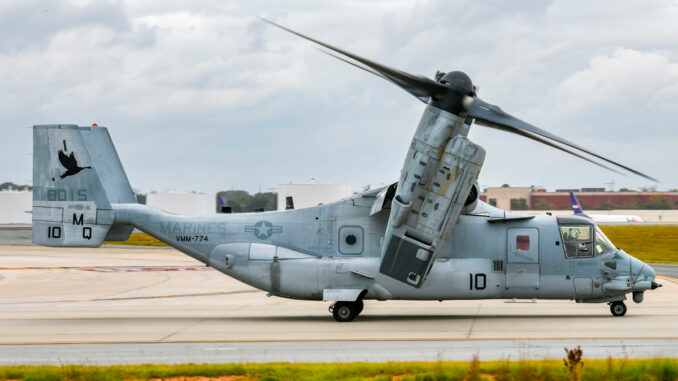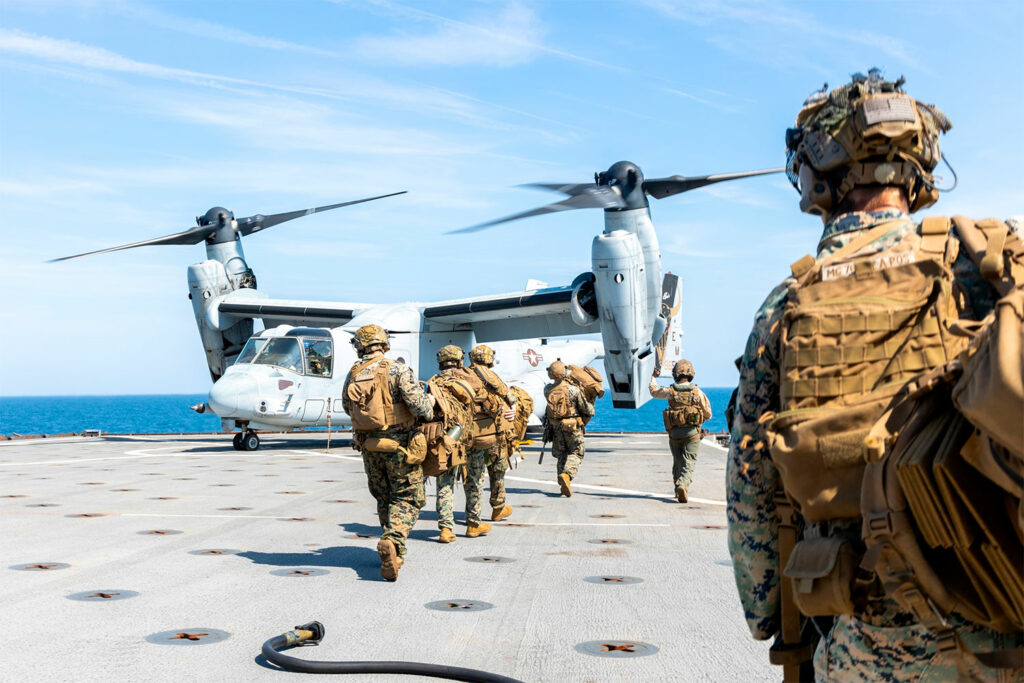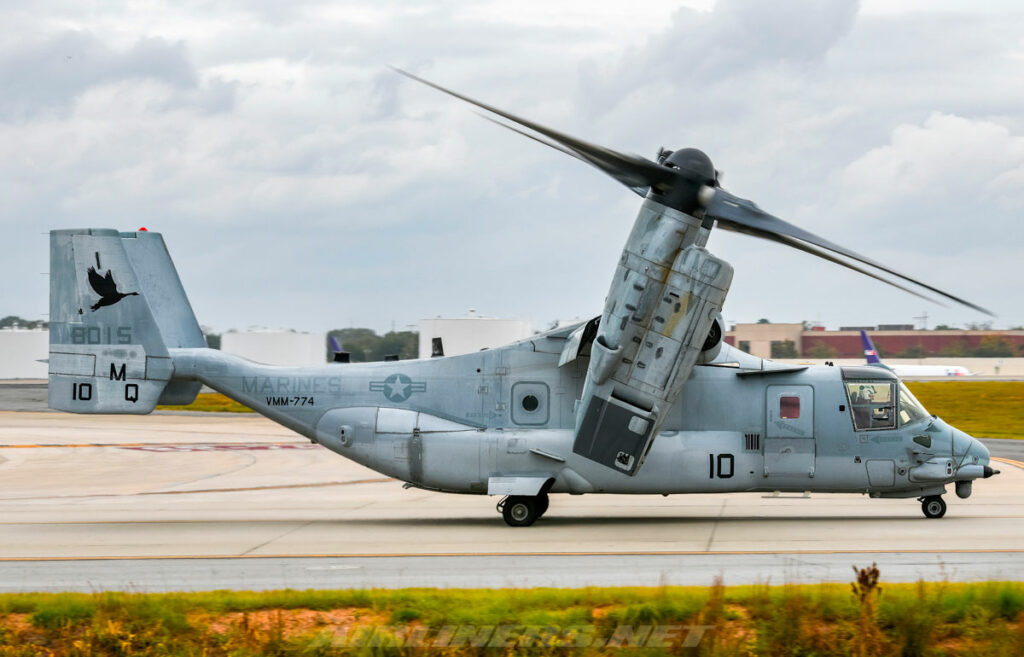
Chesapeake 2025: joint training between French and American forces on the Atlantic coast to strengthen their capacity for joint action.
A military exercise at sea with specific strategic objectives
The Chesapeake 2025 exercise brought together French and American armed forces for a series of coordinated maneuvers off the Atlantic coast. Organized as part of the Special Purpose Marine Air-Ground Task Force – Alert Contingency MAGTF (SPMAGTF-ACM), this training exercise had a clear objective: to test the two countries’ projection, coordination, and strike capabilities in a medium-intensity conflict scenario.
On the American side, the main units were the 26th Marine Expeditionary Unit (MEU) and Marine Medium Tiltrotor Squadron 261, operating MV-22B Osprey aircraft. On the French side, the Jeanne d’Arc group deployed the Mistral helicopter carrier, the Surcouf frigate, as well as Gazelle, Cougar and Dauphin helicopters, S-100 Camcopter tactical drones, and a ground component from the 6th Light Armored Brigade.
More than 940 French and US military personnel took part in the operations, including 640 sailors, 150 French Navy cadets and 150 French soldiers.

Joint coordination of complex amphibious operations
One of the key elements of Chesapeake 2025 was the amphibious deployment. This phase mobilized units from the US Navy, including the USS Oak Hill (LSD 51), Assault Craft Unit FOUR (ACU-4) and Naval Beach Group TWO, to simulate the insertion of troops from the sea to the coast.
The landing was carried out using Landing Craft Air Cushion (LCAC), air-cushioned boats capable of transporting heavy equipment at high speed. This type of platform is designed to operate in coastal areas without port infrastructure, which is the case in many intervention scenarios, particularly in Africa and the Middle East.
The US troops conducted coastal reconnaissance in advance, securing the landing zones, while the French forces simulated logistical and air support. This type of operation requires rigorous planning, real-time communication, and interoperable systems. According to operational officials from both countries, these criteria were met.
Live-fire maneuvers to test tactical effectiveness
The Chesapeake exercise also included live-fire sequences. Several types of weapons were used, including mortars, automatic grenade launchers, heavy machine guns, and individual weapons on dynamic courses.
The Marines conducted coordinated fire with French Gazelle helicopters. These helicopters are capable of providing precision fire support thanks to their HOT or Mistral anti-tank missiles. Air-ground coordination between French and US units was facilitated by the exchange of common procedures, thus validating NATO’s interoperability work.
At the same time, MV-22 Osprey aircraft carried out tactical transport missions, demonstrating their ability to drop troops behind enemy lines at very short notice, without relying on ground infrastructure.
Training that meets today’s challenges
The importance of this type of exercise lies in its ability to simulate a multifaceted conflict: landing, reconnaissance, ground combat, air support, and naval logistics. These scenarios are now at the heart of NATO’s strategic concerns, particularly in the context of tensions in the South China Sea, the eastern Mediterranean, and on Europe’s eastern flank.
Colonel Ben Reid, commander of the 26th MEU, reiterated that this exercise demonstrates “the strength of our relationships with allied forces.” Beyond the rhetoric, the stakes are clear: to test joint rapid response and ensure that chains of command can function seamlessly.
According to Captain Ryan Vanderah, air support officer, “daily cooperation with the French on board their ship has provided a concrete insight into their procedures and effectiveness.” This operational observation is worth more than a simple diplomatic partnership.

The tactical and political interest for France
France’s participation in Chesapeake 2025 is not anecdotal. It confirms Paris’s desire to maintain operational credibility within NATO, while asserting its strategic autonomy. The commitment of the Mistral helicopter carrier, the flagship of French amphibious operations, is testimony to this ambition.
The 6th Light Armored Brigade, which has extensive experience in operations in the Sahel, was also able to test its procedures in a very different context. Far from asymmetric ground combat, the task here was to integrate into a joint and allied logistics chain, where any delay or poor coordination could result in failure.
A full-scale logistical and human test
The success of Chesapeake also depends on an often overlooked logistical aspect: the simultaneous management of hundreds of personnel, weapons systems, ammunition, and communications equipment on vessels with limited capacity. This requires a robust supply chain, compatible data formats, and common security procedures.
The lessons learned from this exercise should inform thinking on interoperability in high-intensity situations. They will also help adapt operational doctrines in a context where Western navies are likely to be called upon to cooperate more frequently, particularly in the face of powers with more aggressive air and naval fleets.
Effectiveness and lessons learned
Chesapeake 2025 was not a symbolic exercise. It was part of a process of real preparation for crisis scenarios, where coordination between allied forces is not limited to theory. The effectiveness demonstrated in a degraded situation, the fluidity of exchanges between commands, and the ability to maneuver quickly confirm that these exercises are essential.
The rise of hybrid threats, the fragility of certain maritime routes, and the proliferation of areas of tension make this type of cooperation essential. But beyond technical resources, it is the men and women involved who must be able to work together at short notice. Chesapeake 2025 demonstrated this in concrete terms.
War Wings Daily is an independant magazine.